

|
Back to |
| The Front Page |
| Letters & Opinion |
|
How we lost Wimbledon
|
|||||||
|
by David Drazin Posted December 6, 2003
|
|
||||||
David Drazin is croquet's bibliographer and its newest historian, with his bid to write the definitive world croquet history (with Croquet Gazette editor James Hawkins), encompassing every aspect of the sport on all the continents. He is recruiting historians in every croquet country to assist with the research and writing. It's a massive undertaking for the tiny world of croquet. "But don't worry," he says. "We're limiting ourselves to only 120,000 words." When I asked Dr. Drazin to write this article, he immediately complied, as I expected he would, and the result made me re-examine my assumptions about organized croquet's early development and Wimbledon's role in it.
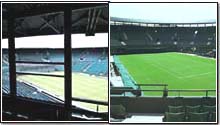
|
| If organized croquet had not refined the game beyond the capacities of its popular mid 19th Century audience, one can imagine these Centre Court galleries filled with croquet fans by the thousands cheering their favorites at major sponsored events. |
And all this without the motorcar or any means of instant communication. There was no radio or telephone, and at a shilling (the equivalent of about $6 at today’s prices) for a twenty-word message over a distance not exceeding 100 miles, the telegram was not a practical option for everyday use. This was a very different world in which ladies and gentlemen had all the time and resources they needed to pursue their cultural, social, and leisure interests in as much depth as they pleased.
Where and when croquet had its origins no one knows, but we do know that it first evolved as a society recreation in Ireland during the first half of the nineteenth century, then trickled quietly into England in the 1850s and took the country by storm in the early 1860s. Croquet parties were all the rage, courts were set out in town squares and village greens, and the first croquet clubs were formed.
Croquet was a byproduct of the Industrial Revolution
Historians are generally agreed that the game’s phenomenal success was due to its novelty in providing an opportunity for men and women, young and old, to compete outdoors on equal terms. And the timing was right. The mechanical lawn mower, invented by Edwin Beard Budding in 1830, was now widely available, allowing the maintenance of fine turf; and a nationwide railway network enabled players to travel to tournaments in distant places.

In those early days the rules of the game were simply transmitted by word of mouth. For want of any recognised authority or rulebook, players could only work out their own ‘house rules’. Thus, croquet became synonymous with anarchy. Lewis Carroll, an early croquet enthusiast, caricatured the game in the story he told the young Liddell sisters, daughters of his college head at Oxford, on 4 July 1862, later published as Alice’s Adventures in Wonderland. ‘"I don’t think they play at all fairly," Alice began, in rather a complaining tone, "and they all quarrel so dreadfully one can’t hear oneself speak - and they don’t seem to have any rules in particular; at least, if there are, nobody attends to them ..."’
Manufacturers of croquet goods and self-styled experts swamped the market with a plethora of rulebooks and introductory manuals, but these merely aggravated the problem. Correspondents besieged the sporting press with queries. How could the discrepant accounts they had found in various sources be reconciled? By good chance, The Field (‘The Country Gentleman’s Journal’) was managed at that time by John Henry Walsh, a sports writer of vision and influence. Impressed by the game’s potential as a serious sport, he took croquet under his wing and used the columns of The Field to bring order out of chaos. In this endeavour he was supported by a growing band of devotees, notably including Walter Whitmore Jones, a wayward genius who changed his name in 1867 to Jones Whitmore and is now widely regarded as the father of modern croquet. The first coherent product of this ill-assorted group was ‘The Field Rules’, largely compiled by Whitmore and published by The Field in 1866.
The increasingly exacting demands of a growing number of serious players soon proved that a single journal could never lead the development of a rapidly growing sport. Writing to The Field in May 1868 under the assumed name of ‘Meliora Spero’ (which means 'I hope for something better'), Dr. Richard Chandler Alexander Prior, a respected scholarly figure who had given up medicine for croquet, suggested the formation of an association of leading players to spearhead this development, just as the Marylebone Cricket Club had led the development of cricket.
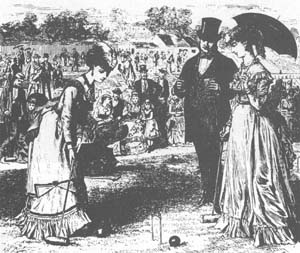
|
| The All-England Croquet Club, from The Illustrated London News, July 1870. In the foreground: Miss Walsh, Mr. and Mrs. J.H. Walsh. |
But towards the end of 1869 Walsh’s faction stole a march on Whitmore by leasing a site in Wimbledon, which was to become the club’s permanent home until 1922, when it moved to its present site in Church Road, on the other side of the village.
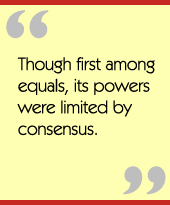
Having set up home, the Wimbledon club could flex its muscles, but it never succeeded in achieving total supremacy of the game. Though first among equals, its powers were limited by consensus. So when it sought to compile an authoritative code of laws, it could only do so in consort with other leading clubs in the country. And the General Conference of Croquet Clubs, which approved a draft code of laws in January 1870, turned to Whitmore to produce the finished work.
On Whitmore’s early death in 1872, the battle-weary players and administrators could enjoy a brief respite. The secessionists had been welcomed back to Wimbledon, the club had established the premier tournament, the Open Championships, and it had secured the guardianship of the game’s law-making body, the ‘Conference’ of leading clubs. Peace broke out all over. Bigger and better championships were staged, players flocked to the new Mecca of croquet, and the game quickly attained something like maturity.
Had it not been for Sphairistike...
And so everyone might have lived happily ever after, had it not been for Major Walter Wingfield’s invention in 1874 of ‘Sphairistiké’ - lawn tennis. The Wimbledon club set out its first experimental lawn tennis court in 1875, and in no more than five years croquet at Wimbledon was history. The club had changed its name, first in 1877 to the All-England Croquet and Lawn Tennis Club and then in 1882 to the All-England Lawn Tennis Club. It abrogated its guardianship of the Conference Code of laws, discontinued all croquet competitions, and turned over its lawns to lawn tennis.
Collapse of the croquet establishment
With the loss of Wimbledon, the emergent croquet establishment collapsed. Championship croquet ceased, and most of the clubs in the country withered away. The game continued to be played outside the public gaze at Oxford colleges and private homes, but it was 15 years before the hard core of croquet die-hards regrouped under the leadership of Walter Peel to form a new national association, the United All England Croquet Association, which soon changed its name to the Croquet Association, the present English national governing body for the sport.
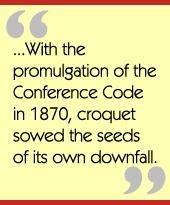
Though we may now speculate on the underlying causes of croquet’s temporary eclipse, the circumstances that precipitated it are clear enough. In reaching its zenith with the promulgation of the Conference Code in 1870, croquet sowed the seeds of its own downfall. The very refinement of the game, marked by the reduction of the width of tournament hoops to 3¾-inch and the introduction of the six-hoop Hale setting in 1872, narrowed its appeal to a shrinking coterie of dedicated players. Thus, in the following years, the numbers of entrants to major events steadily declined.
Game, set, match!
Notwithstanding the hopes and expectations of Whitmore, Walsh, Prior, and others, croquet had never made any serious money, so the viability of all clubs depended on the goodwill of their members. At Wimbledon that goodwill was put in peril by the growing popularity of lawn tennis, which turned in useful profits almost from the word go. The Open Championships never did much better than break even, but in 1882 it was reported that the last three lawn tennis championships had made a handsome profit of £350 (about $42,000 at today’s prices). Game, set, and match! The way forward was crystal clear.
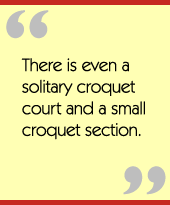
As a lawn tennis club, Wimbledon has never looked back. To this day the status of its Open Lawn Tennis Championships has never been challenged. Though the grounds at Wimbledon are now owned jointly by the club and the British Lawn Tennis Association, it remains a private members’ club, managed by a committee elected by its members, as it was in the beginning. Visitors to Wimbledon today will be impressed by the club’s focus on excellence in all aspects of lawn tennis. But members of the club continue to compete in club and inter-club events in other games as well. There is even a solitary croquet court and a small croquet section.
When the success of lawn tennis was fully assured, the club could afford to reconnect with its roots. In 1897, as a gesture of reconciliation, it offered support to the newly founded UAECA (United All England Croquet Association) by hosting its first open championships. And so the club came once again to acknowledge its croquet heritage, which it proclaimed to the world in 1900 by changing its name, yet again, to the All-England Lawn Tennis and Croquet Club. And ever since it has proved a sympathetic and beneficent supporter of croquet.
In recent years, the club donated the Wimbledon Cup, a handsome silver trophy, to the World Croquet Federation, to be presented to the winners of the WCF Open Championship; it assigned its proprietary interest in the Open Croquet Championships to the Croquet Association; and it sponsored the Croquet Association’s 1897-1997 Centenary Exhibition at the Wimbledon Lawn Tennis Museum.
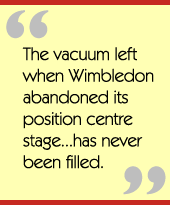
While it is thus gratifying that Wimbledon, once lost, was later regained, the Croquet Association, funded largely by its affiliated clubs and individual members, has always had to look to its own resources. As it turned out, the vacuum left when Wimbledon abandoned its position centre stage of British croquet in 1882 has never been filled like for like. Wimbledon was and remains an independent members’ club. Though its founders intended that it should play a leading role in promoting standards of excellence, it never succeeded in securing the powers of a national governing body in croquet, lawn tennis, or any other sport. On the rebirth of British tournament croquet in 1897, that role was assumed by the CA which, like most other national associations that have since been established, has never sought to offer ordinary club facilities and has never had grounds it could call its own.

|
| The offices of the Croquet Association at the Cheltenham Croquet Club today. (Photo courtesy of James Hawkins.) |
In the grand scheme of things, the loss of Wimbledon was not in itself such a crushing blow to the evolution of British croquet. The decline of the game in the mid-1870s was due to other, more fundamental causes, and would probably have taken the same course, whatever the fate of any single club. And if, in 1882, the leading lights at Wimbledon had not turned against croquet so savagely, it would still have remained just one star in the firmament, however brilliant.
'It would be hard to resist pursuing this 'What if ...?' line of speculation to the present day. And it is perhaps no less hard to escape the conclusion that, if Wimbledon had not been lost, the state of croquet today would in fact be much as we know it.
For so long as there was demand for open and inter-club competition, the need for a national association or governing body was bound to have asserted itself. Its inevitability was an historical necessity. And Wimbledon, however bright its meteoric place in the croquet firmament, could never, as a members' club, fill that role.
NOTE: David Drazin would like to hear from anyone who has copies to spare of old souvenir programs, trade catalogs, club handbooks, and the like. He wants to ensure that such ephemera, at serious risk of disappearing without trace, remain accessible to croquet scholars for all time as a part of his expanding bibliography. Such material could also contribute to Dr. Drazin's new history of croquet. Send David Drazin an email about your mouldering little treasure at: d.drazin@ntlworld.com.